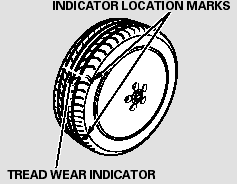Honda CR-V: Tire Inspection
Every time you check inflation, you should also examine the tires for damage, foreign objects, and wear.
You should look for:
Bumps or bulges in the tread or side of the tire. Replace the tire if you find either of these conditions.
Cuts, splits, or cracks in the side of the tire. Replace the tire if you can see fabric or cord.
Excessive tread wear.

Your tires have wear indicators molded into the tread. When the tread wears down, you will see a 1/2 inch (12.7 mm) wide band across the tread. This shows there is less than 1/16 inch (1.6 mm) of tread left on the tire.
A tire this worn gives very little traction on wet roads. You should replace the tire if you can see three or more tread wear indicators.
READ NEXT:
 Tire Service Life
Tire Service Life
The service life of your tires is
dependent on many factors,
including, but not limited to, driving
habits, road conditions, vehicle
loading, inflation pressure,
maintenance history, speed,
 Tire Maintenance
Tire Maintenance
In addition to proper inflation,
correct wheel alignment helps to
decrease tire wear. If you find a tire
is worn unevenly, have your dealer
check the wheel alignment.
Have your dealer check t
 Tire Rotation
Tire Rotation
To help increase tire life and
distribute wear more evenly, rotate
the tires according to the
maintenance messages displayed on
the information display.Move the
tires to the positions show
SEE MORE:
 Overview of Contents
Overview of Contents
Contents
A convenient reference to the
sections in this manual.
Your Vehicle at a Glance
A quick reference to the main
controls in your vehicle.
Driver and Passenger Safety
Important information about the
proper use and care of your vehicle’s
seat belts, an overview of the
supplemen
 Intermediate Shaft
Intermediate Shaft
Intermediate Shaft Removal
1. Drain the automatic transmission fluid. Reinstall the drain plug with a
new washer.
2. Remove the right driveshaft.
3. Remove the flange bolt (A) and two dowel bolts (B).
4. Remove the intermediate shaft (A) from the
differential. Hold the intermediate shaft horizon
© 2016-2025 Copyright www.hcrv.net

